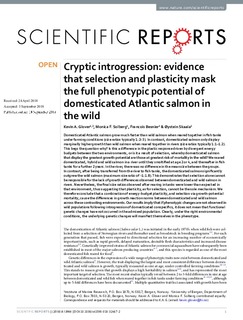| dc.description.abstract | Domesticated Atlantic salmon grow much faster than wild salmon when reared together in fish tanks under farming conditions (size ratios typically 1:2–3). In contrast, domesticated salmon only display marginally higher growth than wild salmon when reared together in rivers (size ratios typically 1:1–1.2). This begs the question why? Is this a difference in the plastic response driven by divergent energy budgets between the two environments, or is it a result of selection, whereby domesticated salmon that display the greatest growth-potential are those at greatest risk of mortality in the wild? We reared domesticated, hybrid and wild salmon in a river until they smoltified at age 2 or 4, and thereafter in fish tanks for a further 2 years. In the river, there was no difference in the mean size between the groups. In contrast, after being transferred from the river to fish tanks, the domesticated salmon significantly outgrew the wild salmon (maximum size ratio of ~1:1.8). This demonstrates that selection alone cannot be responsible for the lack of growth differences observed between domesticated and wild salmon in rivers. Nevertheless, the final size ratios observed after rearing in tanks were lower than expected in that environment, thus suggesting that plasticity, as for selection, cannot be the sole mechanism. We therefore conclude that a combination of energy-budget plasticity, and selection via growth-potential mortality, cause the differences in growth reaction norms between domesticated and wild salmon across these contrasting environments. Our results imply that if phenotypic changes are not observed in wild populations following introgression of domesticated conspecifics, it does not mean that functional genetic changes have not occurred in the admixed population. Clearly, under the right environmental conditions, the underlying genetic changes will manifest themselves in the phenotype. | nb_NO |
